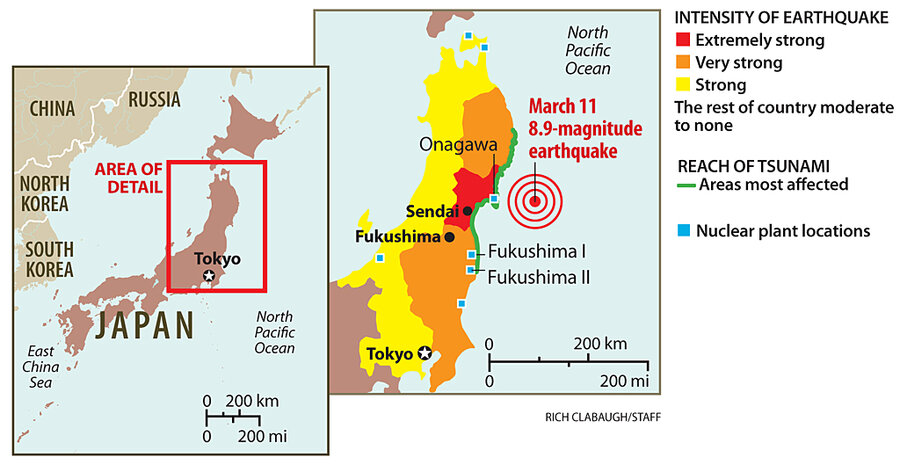Japanese nuclear reactor update: Amid signs of progress, new problems
Loading...
Two Japanese nuclear reactors whose cooling systems were knocked out following an earthquake and tsunami were joined Monday morning by a third reactor that lost its cooling system. All three now are assumed at risk of partial or total meltdowns of their radioactive-fuel cores.
Still, one US nuclear expert said there was at least a glimmer of positive news emerging, with two of the three reactors showing signs of coming under control.
"Units No. 1 and No. 3 seem to be trending to more stable conditions and increasing safety margins," said Dave Lochbaum, a nuclear engineer and director of the Union of Concerned Scientist Nuclear Safety Program (UCS), a US nuclear safety watchdog group, in a conference call with reporters. No. 2, however, remains in an unstable, volatile situation, he said.
Two explosions over the weekend – apparently due to hydrogen buildup – ripped apart buildings housing the No. 1 and No. 3 reactors at the Fukushima I plant, about 150 miles north of Tokyo and owned by the Tokyo Electric Power Co. (TEPCO). The explosions injured workers and complicated efforts to flood the reactors to keep them cool.
Yet those explosions did not puncture the steel containment vessel – shaped like an inverted light bulb – now keeping high amounts of radioactivity bottled up, the plant owner said. Even so, all three reactors’ cores have been exposed to air, and so are assumed to have melted or become damaged to some degree, Japanese and international authorities reported.
Detection of the highly radioactive cesium-137 and iodine-131 outside the Fukushima I plant suggests that fuel has melted and at least some cores have sustained damage. On Monday morning in Japan, the No. 2 reactor joined the other two in losing coolant for a period, thus exposing to the air fuel rods that must be kept underwater in order to avoid partial or complete melting.
To get water into the reactor to cool it, authorities are now forced to vent radioactive steam. The plant is now emitting as much radiation in an hour as it would normally release in six months.
“The possibility that a large amount of radiation has been released is low,” Yukio Edano, the chief government spokesman, said at a news conference.
An emerging issue: spent fuel
Cooling the three reactors isn't the only problem. Cooling spent fuel stored in an adjacent spent-fuel pool at one troubled reactor could be an emerging issue, according to a TEPCO press release on March 13.
"We are currently coordinating with the relevant authorities and departments as to how to secure the cooling water to cool down the water in the spent nuclear fuel pool," the release said. Just how serious the cooling problem is remains publicly unknown, but raises concerns for some US nuclear experts.
A particular feature of the 40-year old General Electric Mark 1 Boiling Water Reactor model – such as the six reactors at the Fukushima site – is that each reactor has a separate spent-fuel pool. These sit near the top of each reactor and adjacent to it, so that cranes can remove spent fuel from the reactor and deposit it in a swimming-pool-like concrete structure near the top of the reactor vessel, inside each reactor building.
If the hydrogen explosions damaged those pools – or systems needed to keep them cool – they could become a big problem. Keeping spent-fuel pools cool is critical and could potentially be an even more severe problem than a reactor meltdown, some experts say. If water drains out, the spent fuel could produce a fire that would release vast amounts of radioactivity, nuclear experts and anti-nuclear activists warn.
"There should be much more attention paid to the spent-fuel pools," says Arjun Makhijani, a nuclear engineer and president of the anti-nuclear power Institute for Energy and Environmental Research. "If there's a complete loss of containment [and thus the water inside], it can catch fire. There's a huge amount of radioactivity inside – far more than is inside the reactors. The damaged reactors are less likely to spread the same vast amounts of radiation that Chernobyl did, but a spent-fuel pool fire could very well produce damage similar to or even greater than Chernobyl."
But another scientist said while the spent-fuel pools have capacity for high volumes of radioactive material, the amount of fuel currently in the spent-fuel pool might be less than widely believed, based on data he has seen showing only about as much spent fuel in the vulnerable pool as contained in the reactor.
"The inventory numbers I've seen for the spent-fuel pool [that was losing coolant] is well below capacity," said Edwin Lyman, a physicist with UCS, which describes itself as neither pro- nor anti-nuclear power, but which says nuclear safeguards today are not adequate. "That could limit the damage."
The US Seventh Fleet, which patrols the seas near Japan but does not publish its precise whereabouts, reportedly detected small amounts of radiation drifting in the vicinity of its ships, so moved the fleet to a different location.
The threat from plutonium-rich MOX
Another little-reported concern is a small but potentially dangerous amount of plutonium-based "MOX" – mixed-oxide fuel – inside the No. 3 reactor, says Dr. Lyman, who notes that plutonium particles are more dangerous to the human body than other particles that might be emitted.
Tokyo Electric said some three yards of a MOX fuel rod was above the water line, suggesting that plutonium and other elements could be in the gases vented to the atmosphere, reported the Kyodo News Agency.
"If the core of that No. 3 reactor melts and venting occurs, some of that plutonium and other nasty elements present in that fuel could end up on the winds," Lyman says.






